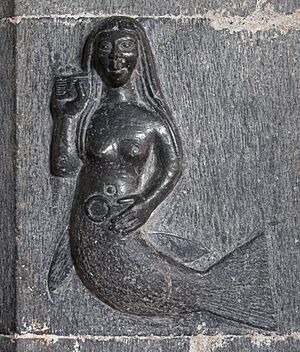Merrow facts for kids

The Merrow is a magical creature from Irish stories. It is like a mermaid or merman. The word "Merrow" comes from the Irish word murúch.
Merrows are said to have a special magic cap. This cap is called a cochaillín draíochta (say: co-hull-een dree-ock-ta). They need this cap to travel between the deep ocean and dry land.
Contents
What are Merrows Like?
Merrows are often described as beautiful. They are half-human and half-fish. From their waist up, they look like a gorgeous woman. Below their waist, they have a fish tail. This tail is often covered with greenish scales. Merrows also have green hair. They love to comb their hair. They might even have small webs between their fingers.
Merrows are usually seen as kind and gentle. They can even fall in love with humans. Some stories tell of Merrows marrying people from the land. Their children might have scaly skin or webbed fingers and toes. But Merrows often feel a strong pull back to the sea. To keep a Merrow on land, her magic cap must be hidden. If she finds it, she will likely return to the ocean.
Merrow music is very special. It can be heard from deep in the ocean. The sound floats gently across the water. Merrows love to dance to this music. They dance on the beach or on the waves.
Merrow-Men
Most Merrow stories are about the female Merrows. But there are also tales about male Merrows. These male Merrows are often described as very ugly. They might have green hair and teeth. They can have pig-like eyes and a red nose. They also have a tail and stubby, fin-like arms. Their ugliness might be why female Merrows look for human men.
One famous story about a male Merrow is "The Soul Cages". In this tale, a merman named Coomara collects the souls of drowned sailors. He keeps them in cages under the sea. This story was actually made up by a writer. But some similar folk tales were found in Ireland later.
The Magic Cap: Cohuleen Druith
The Merrow's special hat is called a cohuleen druith. This cap lets them dive deep into the water. If a Merrow loses her cap, she cannot go back into the sea.
In Irish, the cap's name means "little magic hood." It is like a small, magical cloak. Some people thought the cap looked like a strange, pointed hat.
The idea of a magic item that lets a sea creature live on land is common in folklore. It is similar to stories about "swan maidens." These are women who can turn into swans by wearing a special feather cloak. If their cloak is taken, they cannot fly away. The Merrow's cap works in a similar way.
Some stories say the cohuleen druith is red. This color is not always mentioned in older tales.
Merrows in Old Irish Writings
Merrows and similar sea creatures appear in very old Irish writings. These writings are from the Middle Ages and later.
One old book is called the Book of Invasions (Lebor Gabála Érenn). It tells how the ancient ancestors of the Irish people traveled across the Caspian Sea. They met siren-like creatures called murdúchand. These creatures sang beautiful songs. Their music made the sailors fall asleep. Then the murdúchand would drag the sailors into the sea and eat them. To stay safe, a wise druid told the sailors to put wax in their ears. This is like the story of Odysseus and the Sirens in Greek myths.
A later version of the Book of Invasions describes these sea monsters. It says they look like beautiful women from the waist up. They have long, yellow hair. But from the waist down, they are fish. They sing lovely songs to ships. When sailors fall asleep, the monsters eat them.
Another old collection of tales is the Dindsenchas. These stories explain how different places in Ireland got their names. Some of these tales feature mermaids.
For example, one story tells of a man named Roth. He was killed by mermaids in the English Channel. His thigh washed ashore, giving a place its name. These mermaids were beautiful on top. But below the water, they had hairy, clawed, beast-like lower bodies. They also sang songs that made people sleep. Then they would tear their victims apart and eat them.
Another tale from the Dindsenchas explains the name of Assaroe Falls. A woman named Ruad was lulled to sleep by a "mermaid's melody" and drowned. The falls were named after her.


